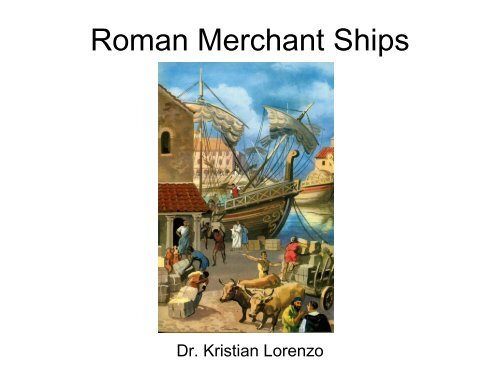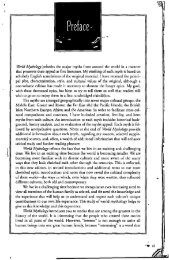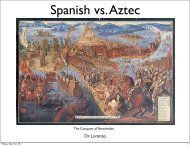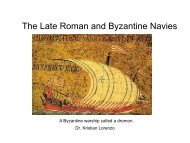10-29-2012-RomanPres-7-Roman-Merchant-Ships - Emmaf.org
10-29-2012-RomanPres-7-Roman-Merchant-Ships - Emmaf.org
10-29-2012-RomanPres-7-Roman-Merchant-Ships - Emmaf.org
Create successful ePaper yourself
Turn your PDF publications into a flip-book with our unique Google optimized e-Paper software.
<strong>Roman</strong> <strong>Merchant</strong> <strong>Ships</strong><br />
Dr. Kristian Lorenzo
<strong>Roman</strong> <strong>Merchant</strong> <strong>Ships</strong>: Today’s Topics<br />
<strong>Roman</strong> Aristocratic Attitudes towards Trade<br />
Monte Testaccio<br />
<strong>Merchant</strong> Ship Design vs. Warship Design<br />
The Madrague de Giens Wreck<br />
The Commachio Wreck<br />
The Torre Sgarrata Wreck<br />
Why study <strong>Roman</strong> <strong>Merchant</strong> wrecks?
<strong>Roman</strong> Attitudes Toward Trade<br />
The <strong>Roman</strong> aristocracy on the whole maintained a distance from direct<br />
involvement in trade, however…<br />
They could benefit from the profits of trade through intermediaries. For example<br />
an aristocrat’s freedmen could manage their former owner’s investments in<br />
potteries, mines, textile production, oil, wine, grain, etc.<br />
Even people such as Cato the Elder (234-149 BC), despite his conservative<br />
attitudes, began to invest in overseas trade. He went as far as investing in<br />
speculative trading ventures by purchasing small shares in large mercantile<br />
consortia thereby spreading the risk.
Cato the Elder, 123-49 BC<br />
“He used to loan money out in the most disreputable of all ways, namely<br />
in shipping, and according to the following formula. He required his<br />
borrowers to form a large company, and when there were fifty partners<br />
and as many ships for his security, he invested in one share of the<br />
company. He event sent his freedman, Quintio, along on all their<br />
ventures. In this way his entire security was not imperilled, but only a<br />
small part of it, and his profits were large.”<br />
Plutarch (Cat. Mai. 21.6)
Monte Testaccio<br />
An artificial mound ca. 118 ft. tall and covering roughly 66,000 sq. ft. of<br />
pottery sherds in Rome created by centuries of discarded, broken amphorae.
Monte Testaccio<br />
Laid down from the 1 st to the mid-3 rd centuries AD, and mostly composed of oil<br />
amphorae from Spain with a smaller amount from North Africa and evidence for<br />
an estimated oil trade in the city of ca. 50,600,000 lbs
Monte Testaccio<br />
Laid down from the 1 st to the mid-3 rd centuries AD, and mostly composed of oil<br />
amphorae from Spain with a smaller amount from North Africa and evidence for<br />
an estimated oil trade in the city of ca. 50,600,000 lbs
<strong>Roman</strong> <strong>Merchant</strong> <strong>Ships</strong> vs. Warships<br />
<strong>Merchant</strong> ship designs are relatively<br />
invariable like cargo boxes.<br />
Warship designs are very variable<br />
depending on the weaponry, fighting<br />
force, and method of propulsion.
<strong>Roman</strong> <strong>Merchant</strong> <strong>Ships</strong><br />
Cargo ships are built heavily (or sturdily) with a normal length to beam of 1:3<br />
(i.e. short and stocky)
<strong>Roman</strong> Warships<br />
A <strong>Roman</strong> Trireme<br />
Warships are built lightly with a normal length to beam ratio of 1:5 or 1:6 (i.e. long<br />
and skinny)
<strong>Roman</strong> <strong>Merchant</strong> Ship: the Madrague de<br />
Giens wreck<br />
Discovered in 1967 of the<br />
sounthern coast of France<br />
near the little fishing port of<br />
La Madrague de Giens<br />
some 30 km. east of Toulon<br />
Excavated from 1972-1982<br />
at depth of ca. 54-60 ft.<br />
300-400 ton ship over 120<br />
ft. long and 27 ft. wide and<br />
with a hull depth of 13.5 ft.<br />
One of the largest ancient<br />
wrecks ever found
The Madrague de Giens wreck<br />
The cargo included about 6,000 to 6,500 wine amphora, all of Dressel Type 1B,<br />
which were stacked in 3 layers, 9 ft. high
The Madrague de Giens wreck: Dressel Type IB<br />
Key: 1 – rim; 2 – neck; 3 – handle; 4 – shoulder; 5 – belly or body; 6 – toe.
The Madrague de Giens wreck: Dressel Type IB<br />
Many of the amphorae displayed potters stamps, the most frequent one was Publius<br />
Veveius Papus, which allows the origin of the amphora to the traced to Terracina,<br />
Italy.
Amphorae Stamps from the Villa of the Laecanius family<br />
Located on the coast of Croatia at Fazana and Brijuni the Laecanii had villas with at<br />
least one workshop producing amphorae for oil.
Amphorae Stamps from the Villa of the Laecanius family<br />
Each amphora was stamped twice both on the rim, Laecanius’s at the center and the<br />
estate manager’s above one of the handles
The Madrague de Giens wreck<br />
A secondary cargo of black glazed pottery was placed in boxes above the amphora,<br />
perhaps as a space filler?
The Madrague de Giens wreck: the Hull<br />
A large section of the hull was preserved by being sandwiched between the layers<br />
of amphorae and the sea bed and then buried my sediment, dead marine life, etc.
The Madrague de Giens wreck<br />
Some of the wreck’s cargo in situ during excavation.
The Madrague de Giens wreck: Urinatores<br />
The wreck also provided evidence that professional urinatores had attempted to<br />
salvage some of the cargo.
The Madrague de Giens wreck: Ballast Stone<br />
The evidence for this were ballast stones that were found throughout the cargo -<br />
geological analysis showed that the stones came from the local coast (not shown).
The Madrague de Giens wreck: Urinatores<br />
The urinatores used the stones to help them reach the seabed where they could<br />
recover parts of the cargo. It is estimated that they managed to recover about<br />
half of the amphorae, together with the ship’s anchors and various other pieces<br />
of equipment, including the bilge pump.
A Local Trading Vessel: The Comacchio Wreck<br />
Discovered in 1980, on the outskirts of<br />
Comacchio, Italy on the Adriatic coast<br />
south of Venice<br />
Excavated from 1986-1989<br />
Dated to ca. 12 BC, by dendrochronology<br />
Ca. 60 ft. of the hull preserved<br />
Beached near a river mouth during a<br />
storm with all its cargo
The Comacchio Wreck: The Cargo<br />
The primary cargo were <strong>10</strong>2 lead ingots of Spanish origin, amphorae for food<br />
transport and boxwood logs. An ingot is a specific quantity of metal cast in a<br />
form convenient for shaping, re-melting or refining.
The Comacchio Wreck: The Cargo<br />
North Italic sigillata pottery was also found on board as well as a bronze balance<br />
with which to sell merchandise by retail probably along a small local route in the<br />
region of the Po valley
The Comacchio Wreck: Importance<br />
The variety and rarity of the materials transported by the vessel make this one<br />
of the most significant discoveries ever made in the Ferrara delta. They reflect<br />
the complexity and liveliness of commercial contacts which were redistributed<br />
along the Po River in the late 1 st century BC.
A Marble Transport: the Torre Sgarrata<br />
Shipwreck<br />
Excavated in 1967 in<br />
the Gulf of Taranto, i.e.<br />
Italy’s instep<br />
Coins from the reign of<br />
Commodus, indicate<br />
the ship sank after AD<br />
192<br />
Sank in shallow water,<br />
ca. 30 ft. deep
A Marble Transport: the Torre Sgarrata Shipwreck<br />
The ship was loaded with almost 170 tonnes of rough-cut marble from Asia Minor,<br />
which included 18 sarcophagi, 23 blocks of stone (six of which were alabaster) and<br />
a huge column. There was also thin sheets of marble veneer.
A Marble Transport: the Torre Sgarrata Shipwreck<br />
An unfinished garland sarcophagus from Ephesos in Turkey.
A Marble Transport: the Torre Sgarrata Shipwreck<br />
An almost finished garland sarcophagus from the so-called Licinian tomb in<br />
Rome, ca. AD 150-180. It is made of Dokimeion marble from Turkey.
A Marble Transport: the Torre Sgarrata Shipwreck<br />
One of the ship’s iron anchors was also found and raised with the help of balloon lifts.
A Marble Transport: the Torre Sgarrata Shipwreck<br />
One of the maritime archaeologist’s recording the dimensions of the ship’s iron anchor.
Why Study <strong>Roman</strong> <strong>Merchant</strong> Wrecks?<br />
Yields important data about trade routes<br />
Types of shipped items: oil, grain, olives, stone, ingots, pottery, etc.<br />
The scale of trade, the size of boats and their carrying capacity<br />
Yields important data about local trade
Why Study <strong>Roman</strong> <strong>Merchant</strong> Wrecks?<br />
Yields Important data about international trade<br />
The stamps on certain artifacts can be studied to determine who<br />
produced the product and where it was produced, so<br />
prosopographical* info and region specific economic data<br />
Steps of production i.e. unfinished to finished sarcophagi and other<br />
stone artifacts such as column drums also treated in the same way<br />
*Prosopography – the study of persons or characters, especially their<br />
appearances, careers, personalities, etc., within a historical, literary, or<br />
social context.


